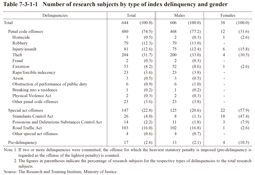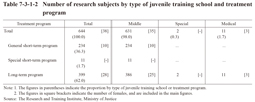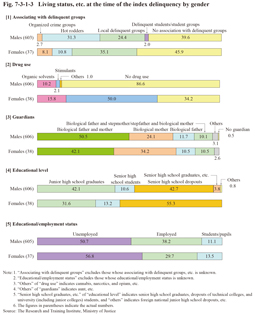Section 1 General Situation of Research Subjects
1 Attributes of research subjects
Table 7-3-1-1 shows the number of research subjects by type of index delinquency and gender while Table 7-3-1-2 by type of juvenile training school and treatment program (See Subsection 2, Section 4, Chapter 1, Part 3 for the types of juvenile training schools and treatment programs). The reason for the percentage of those that received short-term treatment programs (general short-term treatment programs and special short-term treatment programs) being higher with the research subjects (38.8%) than with all the juveniles newly admitted to middle juvenile training schools in 2010 (26.8%; See Table 3-1-4-8) is due to a declining trend in the percentage of those that received short-term treatment programs to all the juveniles newly admitted to juvenile training schools (the percentage of those that received short-term treatment programs to all the juveniles newly admitted to middle juvenile training schools in 2004 was 35.5%; Source: Annual Report of Statistics on Correction).
Table 7-3-1-1 Number of research subjects by type of index delinquency and gender
Table 7-3-1-2 Number of research subjects by type of juvenile training school and treatment program
Fig. 7-3-1-3 shows the status at the time of the index delinquency of the research subjects concerning their associating with delinquent groups, drug use, guardians, educational level, and educational/employment status by gender. Examining their association with delinquent groups revealed that the percentage of those associated with organized crime groups was higher with females than with males and the percentage of those associated with hot rodders higher with males than with females (See Fig. 7-2-3-8). Examining the status of their drug use revealed that the percentage of those that used some type of drug was remarkably higher with females than with males, with approximately 50% of females used stimulants.
The characteristics of the research subjects being senior juveniles who were admitted to juvenile training schools was observed in their educational level and educational/employment status as the percentage of senior high school dropouts was high while the percentage of students/pupils was low with both males and females.
Fig. 7-3-1-3 Living status, etc. at the time of the index delinquency by gender
Fig. 7-3-1-4 shows the history of protective measures of the research subjects before they were committed to juvenile training schools for the index delinquency they committed by gender. The percentage of those with a history of protective measures to total senior juveniles admitted to juvenile training schools was high (See Fig. 7-2-3-3), as was the percentage with research subjects at approximately 70% with males and approximately 60% with females.
Fig. 7-3-1-4 Percent distribution of research subjects by history of protective measures and gender



